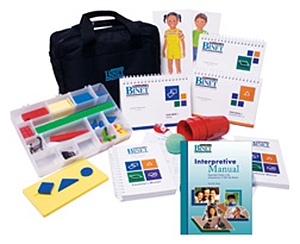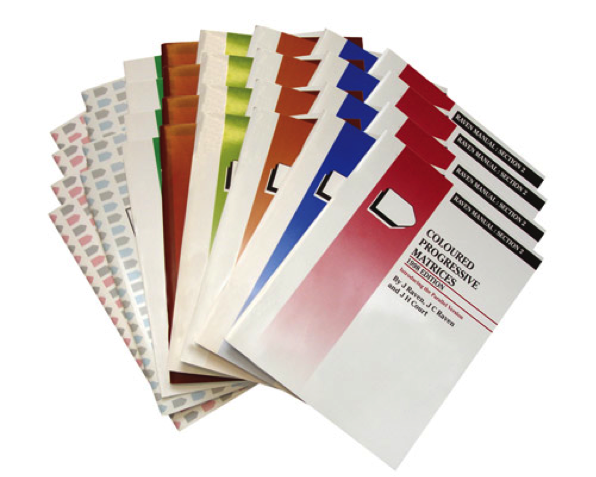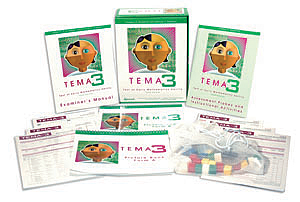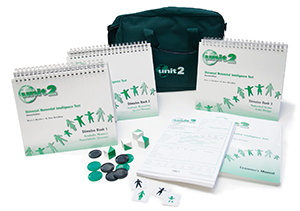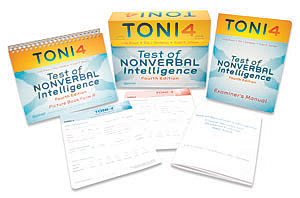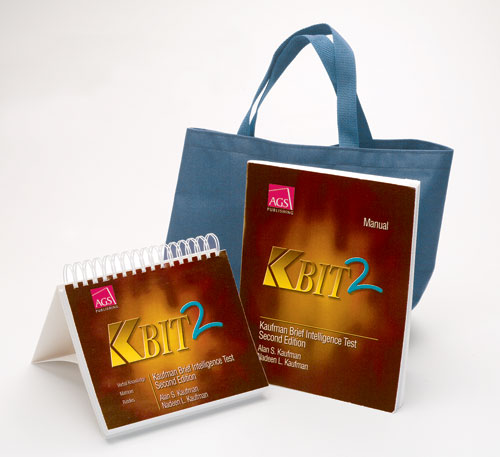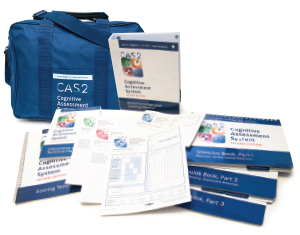
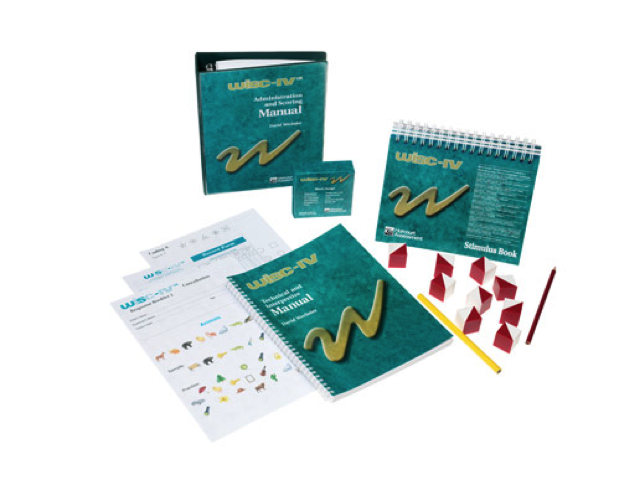
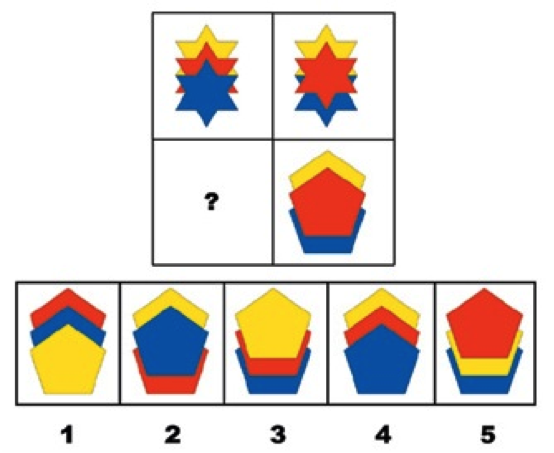 韦克斯勒(韦氏)儿童智力量表第四版( WISC-IV )--韦氏儿童智力量表第五版( WISC-V)
韦克斯勒(韦氏)儿童智力量表第四版( WISC-IV )--韦氏儿童智力量表第五版( WISC-V)
韦氏儿童智力量表第五版(Wechsler Intelligence Scale for Children–Fifth Edition ,WISC-V),是成熟和值得信赖的儿童认知能力测量的新版本。经过重新设计和显著改进,使识别问题和找到解决方案更快,更容易,且保留了韦氏的一贯标准。
开发者:David Wechsler
发布年份:2016年
测试年龄范围:6岁-16岁11个月
格式:纸笔测试,或Q-interactive®测试。测试时长约60分钟
资格代码:CL1
应用——在学校、诊所、医院、大学和法医工作的心理学家及相关专业人员可以利用韦氏儿童智力量表第五版(WISC-V)进行各种应用,例如:识别学习困难,识别和诊断学习障碍,评估认知能力的优势和劣势,评估天赋能力,评估脑损伤后的影响。
内容与测试管理——WISC-V增强了灵活性和解释性的影响力,以及新增更多的子测试,因此可以更广泛地了解孩子的认知能力。扩展的因素结构为测试年龄范围内的提供了新的和独立的视觉空间和流体推理复合材料。
扩展和更新因子结构——测试结构包括用于更大解释清晰度的新的、分离的视觉空间和流体推理复合材料以及用于解释选项的多种层次的复合材料。
新的主要子测试——三个新的主要子测试扩展了韦氏儿童智力量表第五版WISC–V 的内容覆盖范围并增加了其实际应用。视觉拼图(Visual Puzzles )是一种新的视觉空间子测验,用来衡量分析和综合信息的能力。图形权重(Figure Weights)是一个新的流体推理子测验,衡量定量推理和归纳。图片范围(Picture Span)是一个新的工作记忆子测验,衡量视觉工作记忆。
特点与优势
更高效、更人性化。WISC-V在不增加测试时间的情况下增加了结构覆盖率,因此,您将获得更有效、更适合发展的衡量标准——并且仍有时间评估其他感兴趣的领域。高效生成所有一级指标分数。显著减少获得 FSIQ 的测试时间。词汇量减少、中断规则更短、评分标准更精确的简化指令。五个主要指标分数,FSIQ以及五个辅助指标分数中的三个可以通过十个主要子测试获得。
更具解释力
WISC–V提供了与WIAT-III的统计链接,以支持对特定学习障碍进行更灵活的评估,以及识别特定学习障碍的两种主要方法:优缺点模式分析和能力成就差异分析。扩展的分数分析方法突出了指数和子测试水平的优缺点分析。将视觉空间和流体推理复合评分结果分开,解释性清晰度更高。过程分数的选取得到了拓展,增强了对绩效的解释和理解的深度。
更新的心理测量属性
更新了英国6岁-16岁11个月儿童标准化标准样本。根据性别、种族、父母教育水平和每个年龄组的地理区域,对标准样本进行分层,以匹配当前的英国人口普查数据。强大的子测试避免地板和天花板效应,有助于在极端认知能力下进行精确测量。分测验和综合成绩的信度比较及提高。
最新的研究
更新的特殊群体研究。
更新有效性研究和其他措施,包括采用WISC–IV、
WPPSI–IV、
WAIS–IV、
WIAT–III、KTEA-3、
Vineland II和
BASC-2等其他测量进行效度更新研究。扩展了Q-interactive版本的有效性证据,包括Q-interactive和纸/笔格式的结构效度研究和等效性,以及检验频繁测试人群中儿童表现模式的特殊小组研究
韦氏儿童智力量表第五版(WISC–V),完全套装,型号:9780749171780,包括:
管理和评分手册、技术和解释手册、刺激书1和2、25 份记录表格、25 份响应手册1、25 份响应手册2、编码评分模板、符号搜索评分模板、取消评分模板和韦氏标准块设计集、黑色和红色铅笔各1支。所有物品都放置在一个手提包内。
韦氏儿童智力量表第五版(Wechsler Intelligence Scale for Children–Fifth Edition ,WISC-V),文献索引(部分):
-
J Intell. 2023 Jul 10;11(7):137. doi: 10.3390/jintelligence11070137.
《Bootstrap Exploratory Graph Analysis of the WISC-V with a Clinical Sample》
-
J Autism Dev Disord. 2023 Apr 28. doi: 10.1007/s10803-023-05984-x. Online ahead of print.
《Autism and Hierarchical Models of Intelligence》
-
Ann Clin Psychiatry. 2023 May;35(2):157-166. doi: 10.12788/acp.0108.
《Learning and achievement characteristics of sheltered homeless population subgroups》
-
Ultrasound Obstet Gynecol. 2023 Feb 25. doi: 10.1002/uog.26188. Online ahead of print.
《Postnatal genetic and neurodevelopmental assessment in non-placental severely small-for-gestational-age infants born at term》
-
Sleep. 2023 May 10;46(5):zsac317. doi: 10.1093/sleep/zsac317.
《Sleep and neurocognitive outcome in primary school children with Robin Sequence》
-
Genes (Basel). 2023 Jun 26;14(7):1347. doi: 10.3390/genes14071347.
《Description of Neuropsychological Profile in Patients with 22q11 Syndrome》
-
Neuromuscul Disord. 2023 Jun 17;33(7):596-604. doi: 10.1016/j.nmd.2023.06.001. Online ahead of print.
《Clinical study on cognitive impairment in Duchenne muscular dystrophy》
-
Arch Clin Neuropsychol. 2023 Jul 25;acad053. doi: 10.1093/arclin/acad053. Online ahead of print.
《Do executive functions differentiate Iranian children with attention-deficit/hyperactivity disorder with and without comorbid obesity?》
-
Child Neuropsychol. 2023 Feb 2;1-10. doi: 10.1080/09297049.2023.2170996. Online ahead of print.
《Clinical utility of teleneuropsychology among pediatric patients with broadly average and low intellectual functioning》
-
J Intell. 2022 Dec 1;10(4):117. doi: 10.3390/jintelligence10040117.
《Multidimensional Scaling of Cognitive Ability and Academic Achievement Scores》
-
Eur J Paediatr Neurol. 2022 Nov;41:48-54. doi: 10.1016/j.ejpn.2022.09.006. Epub 2022 Sep 29.
《Cognitive profiles in pediatric unilobar vs. multilobar epilepsy》
-
Children (Basel). 2022 Oct 27;9(11):1635. doi: 10.3390/children9111635.
《Accounting for Intraindividual Profiles in the Wechsler Intelligence Scales Improves the Prediction of School Performance》
-
Clin Neuropsychol. 2022 Oct;36(7):1767-1786. doi: 10.1080/13854046.2021.1928290. Epub 2021 Jun 14.
《Assessing IQ in adolescents with mild to moderate cerebral palsy using the WISC-V》
-
J Int Neuropsychol Soc. 2022 Sep;28(8):835-844. doi: 10.1017/S1355617721001053. Epub 2021 Sep 27.
《Equivalency of In-Person Versus Remote Assessment: WISC-V and KTEA-3 Performance in Clinically Referred Children and Adolescents》
-
Scand J Psychol. 2022 Feb;63(1):1-7.doi: 10.1111/sjop.12780. Epub 2021 Nov 9.
《Factor structure of the new Scandinavian WISC-V version: Support for a five-factor model》
-
Appl Neuropsychol Child. Jan-Mar 2022;11(1):50-61.doi: 10.1080/21622965.2020.1747021. Epub 2020 Apr 16.
《Examination of five- and four-subtest short form IQ estimations for the Wechsler Intelligence Scale for Children-Fifth edition (WISC-V) in a mixed clinical sample 》
-
Front Psychol. 2021 Dec 17;12:789124.doi: 10.3389/fpsyg.2021.789124. eCollection 2021.
《A Validated WISC-V Short-Form to Estimate Intellectual Functioning in Very Preterm Children at Early School Age》
-
Pediatr Int. 2021 Dec;63(12):1504-1509.doi: 10.1111/ped.14697. Epub 2021 Oct 29.
《Long-term cognitive outcomes of prematurely born infants: A longitudinal follow-up of Denver II, Bayley III and WISC-IV Tests》
-
Autism Res. 2021 Dec;14(12):2654-2662.doi: 10.1002/aur.2613. Epub 2021 Sep 22.
《Early adversity and positive parenting: Association with cognitive outcomes in children with autism spectrum disorder》
-
Eur J Paediatr Neurol. 2021 Nov;35:74-81.doi: 10.1016/j.ejpn.2021.10.005. Epub 2021 Oct 14.
《Neonatal hypoxic-ischaemic encephalopathy: Motor impairment beyond cerebral palsy》
-
Child Neuropsychol. 2021 Nov;27(8):1024-1053.doi: 10.1080/09297049.2021.1917530. Epub 2021 Apr 30.
《Clinical presentations of attention-deficit/hyperactivity disorder (ADHD) in children and adolescents: comparison of neurocognitive performance》
-
Pediatr Nephrol. 2021 Oct 28;1-10.doi: 10.1007/s00467-021-05280-9. Online ahead of print.
《Prevalence of cognitive dysfunction and its risk factors in children with chronic kidney disease in a developing country》
-
Appl Neuropsychol Child. Oct-Dec 2021;10(4):297-307.doi: 10.1080/21622965.2019.1685522. Epub 2019 Nov 8.
《They're not just little adults: The utility of adult performance validity measures in a mixed clinical pediatric sample》
-
J Clin Psychol Med Settings. 2021 Sep;28(3):619-626.doi: 10.1007/s10880-020-09753-1. Epub 2020 Nov 22.
《Cognitive and Attentional Function in Children with Hypoplastic Left Heart Syndrome: A Pilot Study》
-
Psychiatry Res. 2021 Sep;303:114076.doi: 10.1016/j.psychres.2021.114076. Epub 2021 Jun 27.
《The relationship between intelligence and global adaptive functioning in young people with or without neurodevelopmental disorders》
-
J Clin Child Adolesc Psychol. Sep-Oct 2021;50(5):669-681.doi: 10.1080/15374416.2020.1846543. Epub 2021 Jan 15.
《Validity of the WISC-V in Youth with Autism Spectrum Disorder: Factor Structure and Measurement Invariance》
-
J Int Neuropsychol Soc. 2021 Sep 27;1-10.doi: 10.1017/S1355617721001053. Online ahead of print.
《Equivalency of In-Person Versus Remote Assessment: WISC-V and KTEA-3 Performance in Clinically Referred Children and Adolescents 》
-
Psychiatr Pol. 2021 Aug 31;55(4):869-885.doi: 10.12740/PP/123165. Epub 2021 Aug 31.
《Heterogeneity of cognitive profiles in students with borderline intellectual functioning》
-
J Pediatr Hematol Oncol. 2021 Jul 1;43(5):e666-e676.doi: 10.1097/MPH.0000000000002092.
《Cognitive Functioning and Educational Support Plans in Youth With Sickle Cell Disease》
-
Genes (Basel). 2021 Jul 21;12(8):1108.doi: 10.3390/genes12081108.
《Study of the Interaction between Executive Function and Adaptive Behavior at School in Girls with Fragile X Syndrome》
-
Appl Neuropsychol Child. Jul-Sep 2021;10(3):240-246.doi: 10.1080/21622965.2019.1674653. Epub 2019 Oct 7.
《Sluggish cognitive tempo in children with traumatic brain injuries》
-
Res Dev Disabil. 2021 Jun;113:103934.doi: 10.1016/j.ridd.2021.103934. Epub 2021 Mar 16.
《WISC-V motor-free cognitive profile and predictive factors in adolescents with cerebral palsy》
-
Clin Neuropsychol. 2021 Jun 14;1-20.doi: 10.1080/13854046.2021.1928290. Online ahead of print.
《Assessing IQ in adolescents with mild to moderate cerebral palsy using the WISC-V》
-
Childs Nerv Syst. 2021 Jun;37(6):2033-2038.doi: 10.1007/s00381-021-05089-9. Epub 2021 Mar 11.
《Neuropsychological profiles in children and young adults with spina bifida》
-
Autism Res. 2021 May;14(5):997-1006.doi: 10.1002/aur.2444. Epub 2020 Nov 27.
《WISC-V Profiles and Their Correlates in Children with Autism Spectrum Disorder without Intellectual Developmental Disorder: Report from the ELENA Cohort》
-
注意:韦克斯勒(韦氏)儿童智力量表第四版( WISC-IV ),已经停止销售多时。
-
请仔细阅读以下本产品重要说明。
本产品重要说明:
-
语言:英文
-
计分表格:纸张
-
国际惯例:相应的专业人员购买并使用
-
产品主要参数:WISC-V(Wechsler Intelligence Scale for Children Fifth Edition )
-
原装进口,产地英国
-
尊重并维护知识产权,请按以下列表选择购买使用量表类产品,以实现教学、科研等工作的严谨性和信效度
|
套装 |
|
|
|
9780749171780 |
韦氏儿童智力量表第五版(WISC–V),完全套装 |
电邮询价 |
|
表格(量表) |
|
|
|
9780749171643 |
韦氏儿童智力量表第五版(WISC–V),记录表格(一包25份) |
电邮询价 |
|
9780749171605 |
韦氏儿童智力量表第五版(WISC–V),响应手册1(一包25份) |
电邮询价 |
|
9780749171629 |
韦氏儿童智力量表第五版(WISC–V),响应手册2(一包25份) |
电邮询价 |
|
管理组件 |
|
|
|
9780749171612 |
韦氏儿童智力量表第五版(WISC–V),刺激材料册1 |
电邮询价 |
|
9780749171636 |
韦氏儿童智力量表第五版(WISC–V),刺激材料册2 |
电邮询价 |
|
9780749171568 |
韦氏儿童智力量表第五版(WISC–V),编码评分模板 |
电邮询价 |
|
9780749171599 |
韦氏儿童智力量表第五版(WISC–V),符号搜索评分模板 |
电邮询价 |
|
9780749171582 |
韦氏儿童智力量表第五版(WISC–V),取消评分模板 |
电邮询价 |
|
手册 |
|
|
|
9780749167561 |
韦氏儿童智力量表第五版(WISC–V),管理和评分手册 |
电邮询价 |
|
9780158978482 |
韦氏儿童智力量表第五版(WISC–V),技术和解释手册 |
电邮询价 |
Wechsler Intelligence Scale for Children ( WISC-IV ) Measure a childs intellectual ability with WISC-IV UK. Includes several new subtests to reflect current clinical knowledge and practice Benefits of WISC–IVUK • Expand and strengthen clinical utility to support your decision-making • Develop the four Index Scores as the primary interpretive structure • Improve the assessment of fluid reasoning, working memory and processing speed • Improve subtest reliabilities, floors and ceilings from WISC–IIIUK • Co-normed with the recently published WIAT–IIUK (which replaces the WOND, WORD and WOLD) • Updated, colourful, child-friendly artwork • Instructions to both the examiner and the child are improved to make the WISC–IVUK even more user friendly. Three WISC–IIIUK subtests have been eliminated from WISC–IVUK: Object Assembly, Mazes and Picture Arrangement. WISC–IIIUK subtests that are now supplemental include Picture Completion, Arithmetic and Information. New Subtests Several new subtests are added to reflect current clinical knowledge and practice: • Word Reasoning - measures reasoning with verbal material; child identifies underlying concept given successive clues. • Matrix Reasoning - measures fluid reasoning (a highly reliable subtest on WAIS–IIIUK and WPPSI-III UK); child is presented with a partially filled grid and asked to select the item that properly completes the matrix. • Picture Concepts - measures fluid reasoning, perceptual organisation, and categorisation (requires categorical reasoning without a verbal response); from each of two or three rows of objects, child selects objects that go together based on an underlying concept. • Letter-Number Sequencing - measures working memory (adapted from WAIS–III); child is presented with a mixed series of numbers and letters and repeats them numbers first (in numerical order), then letters (in alphabetical order). • Cancellation - measures processing speed using random and structured animal target forms (foils are common non-animal objects). • In addition, new optional recall procedures have been added to the Coding subtest, including free recall, cued digit recall and cued symbol recall. Four Composite Scores In order to make interpretation more clinical meaningful, the dual IQ and Index structure from WISC–IIIUK has been replaced with a single system of four composite scores (consistent with the Four Index Scores in WISC–IIIUK) and the Full Scale IQ. This new system helps you better understand a child’s needs in relation to contemporary theory and research in cognitive information processing. Age Range:6 years to 16 years 11 months Administration:Individual - Varies by number of subtests administered Publication Year: 2004 Author(s): David Wechsler 9780749128722 WISC-IV - WIAT-II UK Writer complete kit Email for Quotation 9780749128852 Administration Manual Email for Quotation 9780158979199 Technical manual Email for Quotation 9780749128807 Record forms, pack of 25 Email for Quotation 9780749128760 Response booklet 1, pack of 25 Email for Quotation 9780749128814 Response booklet 2, pack of 25 Email for Quotation
Wechsler Intelligence Scale for Children ( WISC-IV ) Measure a childs intellectual ability with WISC-IV UK. Includes several new subtests to reflect current clinical knowledge and practice Benefits of WISC–IVUK • Expand and strengthen clinical utility to support your decision-making • Develop the four Index Scores as the primary interpretive structure • Improve the assessment of fluid reasoning, working memory and processing speed • Improve subtest reliabilities, floors and ceilings from WISC–IIIUK • Co-normed with the recently published WIAT–IIUK (which replaces the WOND, WORD and WOLD) • Updated, colourful, child-friendly artwork • Instructions to both the examiner and the child are improved to make the WISC–IVUK even more user friendly. Three WISC–IIIUK subtests have been eliminated from WISC–IVUK: Object Assembly, Mazes and Picture Arrangement. WISC–IIIUK subtests that are now supplemental include Picture Completion, Arithmetic and Information. New Subtests Several new subtests are added to reflect current clinical knowledge and practice: • Word Reasoning - measures reasoning with verbal material; child identifies underlying concept given successive clues. • Matrix Reasoning - measures fluid reasoning (a highly reliable subtest on WAIS–IIIUK and WPPSI-III UK); child is presented with a partially filled grid and asked to select the item that properly completes the matrix. • Picture Concepts - measures fluid reasoning, perceptual organisation, and categorisation (requires categorical reasoning without a verbal response); from each of two or three rows of objects, child selects objects that go together based on an underlying concept. • Letter-Number Sequencing - measures working memory (adapted from WAIS–III); child is presented with a mixed series of numbers and letters and repeats them numbers first (in numerical order), then letters (in alphabetical order). • Cancellation - measures processing speed using random and structured animal target forms (foils are common non-animal objects). • In addition, new optional recall procedures have been added to the Coding subtest, including free recall, cued digit recall and cued symbol recall. Four Composite Scores In order to make interpretation more clinical meaningful, the dual IQ and Index structure from WISC–IIIUK has been replaced with a single system of four composite scores (consistent with the Four Index Scores in WISC–IIIUK) and the Full Scale IQ. This new system helps you better understand a child’s needs in relation to contemporary theory and research in cognitive information processing. Age Range:6 years to 16 years 11 months Administration:Individual - Varies by number of subtests administered Publication Year: 2004 Author(s): David Wechsler 9780749128722 WISC-IV - WIAT-II UK Writer complete kit Email for Quotation 9780749128852 Administration Manual Email for Quotation 9780158979199 Technical manual Email for Quotation 9780749128807 Record forms, pack of 25 Email for Quotation 9780749128760 Response booklet 1, pack of 25 Email for Quotation 9780749128814 Response booklet 2, pack of 25 Email for Quotation
Wechsler Intelligence Scale for Children ( WISC-IV ) Measure a childs intellectual ability with WISC-IV UK. Includes several new subtests to reflect current clinical knowledge and practice Benefits of WISC–IVUK • Expand and strengthen clinical utility to support your decision-making • Develop the four Index Scores as the primary interpretive structure • Improve the assessment of fluid reasoning, working memory and processing speed • Improve subtest reliabilities, floors and ceilings from WISC–IIIUK • Co-normed with the recently published WIAT–IIUK (which replaces the WOND, WORD and WOLD) • Updated, colourful, child-friendly artwork • Instructions to both the examiner and the child are improved to make the WISC–IVUK even more user friendly. Three WISC–IIIUK subtests have been eliminated from WISC–IVUK: Object Assembly, Mazes and Picture Arrangement. WISC–IIIUK subtests that are now supplemental include Picture Completion, Arithmetic and Information. New Subtests Several new subtests are added to reflect current clinical knowledge and practice: • Word Reasoning - measures reasoning with verbal material; child identifies underlying concept given successive clues. • Matrix Reasoning - measures fluid reasoning (a highly reliable subtest on WAIS–IIIUK and WPPSI-III UK); child is presented with a partially filled grid and asked to select the item that properly completes the matrix. • Picture Concepts - measures fluid reasoning, perceptual organisation, and categorisation (requires categorical reasoning without a verbal response); from each of two or three rows of objects, child selects objects that go together based on an underlying concept. • Letter-Number Sequencing - measures working memory (adapted from WAIS–III); child is presented with a mixed series of numbers and letters and repeats them numbers first (in numerical order), then letters (in alphabetical order). • Cancellation - measures processing speed using random and structured animal target forms (foils are common non-animal objects). • In addition, new optional recall procedures have been added to the Coding subtest, including free recall, cued digit recall and cued symbol recall. Four Composite Scores In order to make interpretation more clinical meaningful, the dual IQ and Index structure from WISC–IIIUK has been replaced with a single system of four composite scores (consistent with the Four Index Scores in WISC–IIIUK) and the Full Scale IQ. This new system helps you better understand a child’s needs in relation to contemporary theory and research in cognitive information processing. Age Range:6 years to 16 years 11 months Administration:Individual - Varies by number of subtests administered Publication Year: 2004 Author(s): David Wechsler 9780749128722 WISC-IV - WIAT-II UK Writer complete kit Email for Quotation 9780749128852 Administration Manual Email for Quotation 9780158979199 Technical manual Email for Quotation 9780749128807 Record forms, pack of 25 Email for Quotation 9780749128760 Response booklet 1, pack of 25 Email for Quotation 9780749128814 Response booklet 2, pack of 25 Email for Quotation
Wechsler Intelligence Scale for Children ( WISC-IV ) Measure a childs intellectual ability with WISC-IV UK. Includes several new subtests to reflect current clinical knowledge and practice Benefits of WISC–IVUK • Expand and strengthen clinical utility to support your decision-making • Develop the four Index Scores as the primary interpretive structure • Improve the assessment of fluid reasoning, working memory and processing speed • Improve subtest reliabilities, floors and ceilings from WISC–IIIUK • Co-normed with the recently published WIAT–IIUK (which replaces the WOND, WORD and WOLD) • Updated, colourful, child-friendly artwork • Instructions to both the examiner and the child are improved to make the WISC–IVUK even more user friendly. Three WISC–IIIUK subtests have been eliminated from WISC–IVUK: Object Assembly, Mazes and Picture Arrangement. WISC–IIIUK subtests that are now supplemental include Picture Completion, Arithmetic and Information. New Subtests Several new subtests are added to reflect current clinical knowledge and practice: • Word Reasoning - measures reasoning with verbal material; child identifies underlying concept given successive clues. • Matrix Reasoning - measures fluid reasoning (a highly reliable subtest on WAIS–IIIUK and WPPSI-III UK); child is presented with a partially filled grid and asked to select the item that properly completes the matrix. • Picture Concepts - measures fluid reasoning, perceptual organisation, and categorisation (requires categorical reasoning without a verbal response); from each of two or three rows of objects, child selects objects that go together based on an underlying concept. • Letter-Number Sequencing - measures working memory (adapted from WAIS–III); child is presented with a mixed series of numbers and letters and repeats them numbers first (in numerical order), then letters (in alphabetical order). • Cancellation - measures processing speed using random and structured animal target forms (foils are common non-animal objects). • In addition, new optional recall procedures have been added to the Coding subtest, including free recall, cued digit recall and cued symbol recall. Four Composite Scores In order to make interpretation more clinical meaningful, the dual IQ and Index structure from WISC–IIIUK has been replaced with a single system of four composite scores (consistent with the Four Index Scores in WISC–IIIUK) and the Full Scale IQ. This new system helps you better understand a child’s needs in relation to contemporary theory and research in cognitive information processing. Age Range:6 years to 16 years 11 months Administration:Individual - Varies by number of subtests administered Publication Year: 2004 Author(s): David Wechsler 9780749128722 WISC-IV - WIAT-II UK Writer complete kit Email for Quotation 9780749128852 Administration Manual Email for Quotation 9780158979199 Technical manual Email for Quotation 9780749128807 Record forms, pack of 25 Email for Quotation 9780749128760 Response booklet 1, pack of 25 Email for Quotation 9780749128814 Response booklet 2, pack of 25 Email for Quotation
Wechsler Intelligence Scale for Children ( WISC-IV ) Measure a childs intellectual ability with WISC-IV UK. Includes several new subtests to reflect current clinical knowledge and practice Benefits of WISC–IVUK • Expand and strengthen clinical utility to support your decision-making • Develop the four Index Scores as the primary interpretive structure • Improve the assessment of fluid reasoning, working memory and processing speed • Improve subtest reliabilities, floors and ceilings from WISC–IIIUK • Co-normed with the recently published WIAT–IIUK (which replaces the WOND, WORD and WOLD) • Updated, colourful, child-friendly artwork • Instructions to both the examiner and the child are improved to make the WISC–IVUK even more user friendly. Three WISC–IIIUK subtests have been eliminated from WISC–IVUK: Object Assembly, Mazes and Picture Arrangement. WISC–IIIUK subtests that are now supplemental include Picture Completion, Arithmetic and Information. New Subtests Several new subtests are added to reflect current clinical knowledge and practice: • Word Reasoning - measures reasoning with verbal material; child identifies underlying concept given successive clues. • Matrix Reasoning - measures fluid reasoning (a highly reliable subtest on WAIS–IIIUK and WPPSI-III UK); child is presented with a partially filled grid and asked to select the item that properly completes the matrix. • Picture Concepts - measures fluid reasoning, perceptual organisation, and categorisation (requires categorical reasoning without a verbal response); from each of two or three rows of objects, child selects objects that go together based on an underlying concept. • Letter-Number Sequencing - measures working memory (adapted from WAIS–III); child is presented with a mixed series of numbers and letters and repeats them numbers first (in numerical order), then letters (in alphabetical order). • Cancellation - measures processing speed using random and structured animal target forms (foils are common non-animal objects). • In addition, new optional recall procedures have been added to the Coding subtest, including free recall, cued digit recall and cued symbol recall. Four Composite Scores In order to make interpretation more clinical meaningful, the dual IQ and Index structure from WISC–IIIUK has been replaced with a single system of four composite scores (consistent with the Four Index Scores in WISC–IIIUK) and the Full Scale IQ. This new system helps you better understand a child’s needs in relation to contemporary theory and research in cognitive information processing. Age Range:6 years to 16 years 11 months Administration:Individual - Varies by number of subtests administered Publication Year: 2004 Author(s): David Wechsler 9780749128722 WISC-IV - WIAT-II UK Writer complete kit Email for Quotation 9780749128852 Administration Manual Email for Quotation 9780158979199 Technical manual Email for Quotation 9780749128807 Record forms, pack of 25 Email for Quotation 9780749128760 Response booklet 1, pack of 25 Email for Quotation 9780749128814 Response booklet 2, pack of 25 Email for Quotation
Wechsler Intelligence Scale for Children ( WISC-IV ) Measure a childs intellectual ability with WISC-IV UK. Includes several new subtests to reflect current clinical knowledge and practice Benefits of WISC–IVUK • Expand and strengthen clinical utility to support your decision-making • Develop the four Index Scores as the primary interpretive structure • Improve the assessment of fluid reasoning, working memory and processing speed • Improve subtest reliabilities, floors and ceilings from WISC–IIIUK • Co-normed with the recently published WIAT–IIUK (which replaces the WOND, WORD and WOLD) • Updated, colourful, child-friendly artwork • Instructions to both the examiner and the child are improved to make the WISC–IVUK even more user friendly. Three WISC–IIIUK subtests have been eliminated from WISC–IVUK: Object Assembly, Mazes and Picture Arrangement. WISC–IIIUK subtests that are now supplemental include Picture Completion, Arithmetic and Information. New Subtests Several new subtests are added to reflect current clinical knowledge and practice: • Word Reasoning - measures reasoning with verbal material; child identifies underlying concept given successive clues. • Matrix Reasoning - measures fluid reasoning (a highly reliable subtest on WAIS–IIIUK and WPPSI-III UK); child is presented with a partially filled grid and asked to select the item that properly completes the matrix. • Picture Concepts - measures fluid reasoning, perceptual organisation, and categorisation (requires categorical reasoning without a verbal response); from each of two or three rows of objects, child selects objects that go together based on an underlying concept. • Letter-Number Sequencing - measures working memory (adapted from WAIS–III); child is presented with a mixed series of numbers and letters and repeats them numbers first (in numerical order), then letters (in alphabetical order). • Cancellation - measures processing speed using random and structured animal target forms (foils are common non-animal objects). • In addition, new optional recall procedures have been added to the Coding subtest, including free recall, cued digit recall and cued symbol recall. Four Composite Scores In order to make interpretation more clinical meaningful, the dual IQ and Index structure from WISC–IIIUK has been replaced with a single system of four composite scores (consistent with the Four Index Scores in WISC–IIIUK) and the Full Scale IQ. This new system helps you better understand a child’s needs in relation to contemporary theory and research in cognitive information processing. Age Range:6 years to 16 years 11 months Administration:Individual - Varies by number of subtests administered Publication Year: 2004 Author(s): David Wechsler 9780749128722 WISC-IV - WIAT-II UK Writer complete kit Email for Quotation 9780749128852 Administration Manual Email for Quotation 9780158979199 Technical manual Email for Quotation 9780749128807 Record forms, pack of 25 Email for Quotation 9780749128760 Response booklet 1, pack of 25 Email for Quotation 9780749128814 Response booklet 2, pack of 25 Email for Quotation
Wechsler Intelligence Scale for Children ( WISC-IV ) Measure a childs intellectual ability with WISC-IV UK. Includes several new subtests to reflect current clinical knowledge and practice Benefits of WISC–IVUK • Expand and strengthen clinical utility to support your decision-making • Develop the four Index Scores as the primary interpretive structure • Improve the assessment of fluid reasoning, working memory and processing speed • Improve subtest reliabilities, floors and ceilings from WISC–IIIUK • Co-normed with the recently published WIAT–IIUK (which replaces the WOND, WORD and WOLD) • Updated, colourful, child-friendly artwork • Instructions to both the examiner and the child are improved to make the WISC–IVUK even more user friendly. Three WISC–IIIUK subtests have been eliminated from WISC–IVUK: Object Assembly, Mazes and Picture Arrangement. WISC–IIIUK subtests that are now supplemental include Picture Completion, Arithmetic and Information. New Subtests Several new subtests are added to reflect current clinical knowledge and practice: • Word Reasoning - measures reasoning with verbal material; child identifies underlying concept given successive clues. • Matrix Reasoning - measures fluid reasoning (a highly reliable subtest on WAIS–IIIUK and WPPSI-III UK); child is presented with a partially filled grid and asked to select the item that properly completes the matrix. • Picture Concepts - measures fluid reasoning, perceptual organisation, and categorisation (requires categorical reasoning without a verbal response); from each of two or three rows of objects, child selects objects that go together based on an underlying concept. • Letter-Number Sequencing - measures working memory (adapted from WAIS–III); child is presented with a mixed series of numbers and letters and repeats them numbers first (in numerical order), then letters (in alphabetical order). • Cancellation - measures processing speed using random and structured animal target forms (foils are common non-animal objects). • In addition, new optional recall procedures have been added to the Coding subtest, including free recall, cued digit recall and cued symbol recall. Four Composite Scores In order to make interpretation more clinical meaningful, the dual IQ and Index structure from WISC–IIIUK has been replaced with a single system of four composite scores (consistent with the Four Index Scores in WISC–IIIUK) and the Full Scale IQ. This new system helps you better understand a child’s needs in relation to contemporary theory and research in cognitive information processing. Age Range:6 years to 16 years 11 months Administration:Individual - Varies by number of subtests administered Publication Year: 2004 Author(s): David Wechsler 9780749128722 WISC-IV - WIAT-II UK Writer complete kit Email for Quotation 9780749128852 Administration Manual Email for Quotation 9780158979199 Technical manual Email for Quotation 9780749128807 Record forms, pack of 25 Email for Quotation 9780749128760 Response booklet 1, pack of 25 Email for Quotation 9780749128814 Response booklet 2, pack of 25 Email for Quotation
Wechsler Intelligence Scale for Children ( WISC-IV ) Measure a childs intellectual ability with WISC-IV UK. Includes several new subtests to reflect current clinical knowledge and practice Benefits of WISC–IVUK • Expand and strengthen clinical utility to support your decision-making • Develop the four Index Scores as the primary interpretive structure • Improve the assessment of fluid reasoning, working memory and processing speed • Improve subtest reliabilities, floors and ceilings from WISC–IIIUK • Co-normed with the recently published WIAT–IIUK (which replaces the WOND, WORD and WOLD) • Updated, colourful, child-friendly artwork • Instructions to both the examiner and the child are improved to make the WISC–IVUK even more user friendly. Three WISC–IIIUK subtests have been eliminated from WISC–IVUK: Object Assembly, Mazes and Picture Arrangement. WISC–IIIUK subtests that are now supplemental include Picture Completion, Arithmetic and Information. New Subtests Several new subtests are added to reflect current clinical knowledge and practice: • Word Reasoning - measures reasoning with verbal material; child identifies underlying concept given successive clues. • Matrix Reasoning - measures fluid reasoning (a highly reliable subtest on WAIS–IIIUK and WPPSI-III UK); child is presented with a partially filled grid and asked to select the item that properly completes the matrix. • Picture Concepts - measures fluid reasoning, perceptual organisation, and categorisation (requires categorical reasoning without a verbal response); from each of two or three rows of objects, child selects objects that go together based on an underlying concept. • Letter-Number Sequencing - measures working memory (adapted from WAIS–III); child is presented with a mixed series of numbers and letters and repeats them numbers first (in numerical order), then letters (in alphabetical order). • Cancellation - measures processing speed using random and structured animal target forms (foils are common non-animal objects). • In addition, new optional recall procedures have been added to the Coding subtest, including free recall, cued digit recall and cued symbol recall. Four Composite Scores In order to make interpretation more clinical meaningful, the dual IQ and Index structure from WISC–IIIUK has been replaced with a single system of four composite scores (consistent with the Four Index Scores in WISC–IIIUK) and the Full Scale IQ. This new system helps you better understand a child’s needs in relation to contemporary theory and research in cognitive information processing. Age Range:6 years to 16 years 11 months Administration:Individual - Varies by number of subtests administered Publication Year: 2004 Author(s): David Wechsler 9780749128722 WISC-IV - WIAT-II UK Writer complete kit Email for Quotation 9780749128852 Administration Manual Email for Quotation 9780158979199 Technical manual Email for Quotation 9780749128807 Record forms, pack of 25 Email for Quotation 9780749128760 Response booklet 1, pack of 25 Email for Quotation 9780749128814 Response booklet 2, pack of 25 Email for Quotation
Wechsler Intelligence Scale for Children ( WISC-IV ) Measure a childs intellectual ability with WISC-IV UK. Includes several new subtests to reflect current clinical knowledge and practice Benefits of WISC–IVUK • Expand and strengthen clinical utility to support your decision-making • Develop the four Index Scores as the primary interpretive structure • Improve the assessment of fluid reasoning, working memory and processing speed • Improve subtest reliabilities, floors and ceilings from WISC–IIIUK • Co-normed with the recently published WIAT–IIUK (which replaces the WOND, WORD and WOLD) • Updated, colourful, child-friendly artwork • Instructions to both the examiner and the child are improved to make the WISC–IVUK even more user friendly. Three WISC–IIIUK subtests have been eliminated from WISC–IVUK: Object Assembly, Mazes and Picture Arrangement. WISC–IIIUK subtests that are now supplemental include Picture Completion, Arithmetic and Information. New Subtests Several new subtests are added to reflect current clinical knowledge and practice: • Word Reasoning - measures reasoning with verbal material; child identifies underlying concept given successive clues. • Matrix Reasoning - measures fluid reasoning (a highly reliable subtest on WAIS–IIIUK and WPPSI-III UK); child is presented with a partially filled grid and asked to select the item that properly completes the matrix. • Picture Concepts - measures fluid reasoning, perceptual organisation, and categorisation (requires categorical reasoning without a verbal response); from each of two or three rows of objects, child selects objects that go together based on an underlying concept. • Letter-Number Sequencing - measures working memory (adapted from WAIS–III); child is presented with a mixed series of numbers and letters and repeats them numbers first (in numerical order), then letters (in alphabetical order). • Cancellation - measures processing speed using random and structured animal target forms (foils are common non-animal objects). • In addition, new optional recall procedures have been added to the Coding subtest, including free recall, cued digit recall and cued symbol recall. Four Composite Scores In order to make interpretation more clinical meaningful, the dual IQ and Index structure from WISC–IIIUK has been replaced with a single system of four composite scores (consistent with the Four Index Scores in WISC–IIIUK) and the Full Scale IQ. This new system helps you better understand a child’s needs in relation to contemporary theory and research in cognitive information processing. Age Range:6 years to 16 years 11 months Administration:Individual - Varies by number of subtests administered Publication Year: 2004 Author(s): David Wechsler 9780749128722 WISC-IV - WIAT-II UK Writer complete kit Email for Quotation 9780749128852 Administration Manual Email for Quotation 9780158979199 Technical manual Email for Quotation 9780749128807 Record forms, pack of 25 Email for Quotation 9780749128760 Response booklet 1, pack of 25 Email for Quotation 9780749128814 Response booklet 2, pack of 25 Email for Quotation
Wechsler Intelligence Scale for Children ( WISC-IV ) Measure a childs intellectual ability with WISC-IV UK. Includes several new subtests to reflect current clinical knowledge and practice Benefits of WISC–IVUK • Expand and strengthen clinical utility to support your decision-making • Develop the four Index Scores as the primary interpretive structure • Improve the assessment of fluid reasoning, working memory and processing speed • Improve subtest reliabilities, floors and ceilings from WISC–IIIUK • Co-normed with the recently published WIAT–IIUK (which replaces the WOND, WORD and WOLD) • Updated, colourful, child-friendly artwork • Instructions to both the examiner and the child are improved to make the WISC–IVUK even more user friendly. Three WISC–IIIUK subtests have been eliminated from WISC–IVUK: Object Assembly, Mazes and Picture Arrangement. WISC–IIIUK subtests that are now supplemental include Picture Completion, Arithmetic and Information. New Subtests Several new subtests are added to reflect current clinical knowledge and practice: • Word Reasoning - measures reasoning with verbal material; child identifies underlying concept given successive clues. • Matrix Reasoning - measures fluid reasoning (a highly reliable subtest on WAIS–IIIUK and WPPSI-III UK); child is presented with a partially filled grid and asked to select the item that properly completes the matrix. • Picture Concepts - measures fluid reasoning, perceptual organisation, and categorisation (requires categorical reasoning without a verbal response); from each of two or three rows of objects, child selects objects that go together based on an underlying concept. • Letter-Number Sequencing - measures working memory (adapted from WAIS–III); child is presented with a mixed series of numbers and letters and repeats them numbers first (in numerical order), then letters (in alphabetical order). • Cancellation - measures processing speed using random and structured animal target forms (foils are common non-animal objects). • In addition, new optional recall procedures have been added to the Coding subtest, including free recall, cued digit recall and cued symbol recall. Four Composite Scores In order to make interpretation more clinical meaningful, the dual IQ and Index structure from WISC–IIIUK has been replaced with a single system of four composite scores (consistent with the Four Index Scores in WISC–IIIUK) and the Full Scale IQ. This new system helps you better understand a child’s needs in relation to contemporary theory and research in cognitive information processing. Age Range:6 years to 16 years 11 months Administration:Individual - Varies by number of subtests administered Publication Year: 2004 Author(s): David Wechsler 9780749128722 WISC-IV - WIAT-II UK Writer complete kit Email for Quotation 9780749128852 Administration Manual Email for Quotation 9780158979199 Technical manual Email for Quotation 9780749128807 Record forms, pack of 25 Email for Quotation 9780749128760 Response booklet 1, pack of 25 Email for Quotation 9780749128814 Response booklet 2, pack of 25 Email for Quotation
Wechsler Intelligence Scale for Children ( WISC-IV ) Measure a childs intellectual ability with WISC-IV UK. Includes several new subtests to reflect current clinical knowledge and practice Benefits of WISC–IVUK • Expand and strengthen clinical utility to support your decision-making • Develop the four Index Scores as the primary interpretive structure • Improve the assessment of fluid reasoning, working memory and processing speed • Improve subtest reliabilities, floors and ceilings from WISC–IIIUK • Co-normed with the recently published WIAT–IIUK (which replaces the WOND, WORD and WOLD) • Updated, colourful, child-friendly artwork • Instructions to both the examiner and the child are improved to make the WISC–IVUK even more user friendly. Three WISC–IIIUK subtests have been eliminated from WISC–IVUK: Object Assembly, Mazes and Picture Arrangement. WISC–IIIUK subtests that are now supplemental include Picture Completion, Arithmetic and Information. New Subtests Several new subtests are added to reflect current clinical knowledge and practice: • Word Reasoning - measures reasoning with verbal material; child identifies underlying concept given successive clues. • Matrix Reasoning - measures fluid reasoning (a highly reliable subtest on WAIS–IIIUK and WPPSI-III UK); child is presented with a partially filled grid and asked to select the item that properly completes the matrix. • Picture Concepts - measures fluid reasoning, perceptual organisation, and categorisation (requires categorical reasoning without a verbal response); from each of two or three rows of objects, child selects objects that go together based on an underlying concept. • Letter-Number Sequencing - measures working memory (adapted from WAIS–III); child is presented with a mixed series of numbers and letters and repeats them numbers first (in numerical order), then letters (in alphabetical order). • Cancellation - measures processing speed using random and structured animal target forms (foils are common non-animal objects). • In addition, new optional recall procedures have been added to the Coding subtest, including free recall, cued digit recall and cued symbol recall. Four Composite Scores In order to make interpretation more clinical meaningful, the dual IQ and Index structure from WISC–IIIUK has been replaced with a single system of four composite scores (consistent with the Four Index Scores in WISC–IIIUK) and the Full Scale IQ. This new system helps you better understand a child’s needs in relation to contemporary theory and research in cognitive information processing. Age Range:6 years to 16 years 11 months Administration:Individual - Varies by number of subtests administered Publication Year: 2004 Author(s): David Wechsler 9780749128722 WISC-IV - WIAT-II UK Writer complete kit Email for Quotation 9780749128852 Administration Manual Email for Quotation 9780158979199 Technical manual Email for Quotation 9780749128807 Record forms, pack of 25 Email for Quotation 9780749128760 Response booklet 1, pack of 25 Email for Quotation 9780749128814 Response booklet 2, pack of 25 Email for Quotation
Wechsler Intelligence Scale for Children ( WISC-IV ) Measure a childs intellectual ability with WISC-IV UK. Includes several new subtests to reflect current clinical knowledge and practice Benefits of WISC–IVUK • Expand and strengthen clinical utility to support your decision-making • Develop the four Index Scores as the primary interpretive structure • Improve the assessment of fluid reasoning, working memory and processing speed • Improve subtest reliabilities, floors and ceilings from WISC–IIIUK • Co-normed with the recently published WIAT–IIUK (which replaces the WOND, WORD and WOLD) • Updated, colourful, child-friendly artwork • Instructions to both the examiner and the child are improved to make the WISC–IVUK even more user friendly. Three WISC–IIIUK subtests have been eliminated from WISC–IVUK: Object Assembly, Mazes and Picture Arrangement. WISC–IIIUK subtests that are now supplemental include Picture Completion, Arithmetic and Information. New Subtests Several new subtests are added to reflect current clinical knowledge and practice: • Word Reasoning - measures reasoning with verbal material; child identifies underlying concept given successive clues. • Matrix Reasoning - measures fluid reasoning (a highly reliable subtest on WAIS–IIIUK and WPPSI-III UK); child is presented with a partially filled grid and asked to select the item that properly completes the matrix. • Picture Concepts - measures fluid reasoning, perceptual organisation, and categorisation (requires categorical reasoning without a verbal response); from each of two or three rows of objects, child selects objects that go together based on an underlying concept. • Letter-Number Sequencing - measures working memory (adapted from WAIS–III); child is presented with a mixed series of numbers and letters and repeats them numbers first (in numerical order), then letters (in alphabetical order). • Cancellation - measures processing speed using random and structured animal target forms (foils are common non-animal objects). • In addition, new optional recall procedures have been added to the Coding subtest, including free recall, cued digit recall and cued symbol recall. Four Composite Scores In order to make interpretation more clinical meaningful, the dual IQ and Index structure from WISC–IIIUK has been replaced with a single system of four composite scores (consistent with the Four Index Scores in WISC–IIIUK) and the Full Scale IQ. This new system helps you better understand a child’s needs in relation to contemporary theory and research in cognitive information processing. Age Range:6 years to 16 years 11 months Administration:Individual - Varies by number of subtests administered Publication Year: 2004 Author(s): David Wechsler 9780749128722 WISC-IV - WIAT-II UK Writer complete kit Email for Quotation 9780749128852 Administration Manual Email for Quotation 9780158979199 Technical manual Email for Quotation 9780749128807 Record forms, pack of 25 Email for Quotation 9780749128760 Response booklet 1, pack of 25 Email for Quotation 9780749128814 Response booklet 2, pack of 25 Email for Quotation
Wechsler Intelligence Scale for Children ( WISC-IV ) Measure a childs intellectual ability with WISC-IV UK. Includes several new subtests to reflect current clinical knowledge and practice Benefits of WISC–IVUK • Expand and strengthen clinical utility to support your decision-making • Develop the four Index Scores as the primary interpretive structure • Improve the assessment of fluid reasoning, working memory and processing speed • Improve subtest reliabilities, floors and ceilings from WISC–IIIUK • Co-normed with the recently published WIAT–IIUK (which replaces the WOND, WORD and WOLD) • Updated, colourful, child-friendly artwork • Instructions to both the examiner and the child are improved to make the WISC–IVUK even more user friendly. Three WISC–IIIUK subtests have been eliminated from WISC–IVUK: Object Assembly, Mazes and Picture Arrangement. WISC–IIIUK subtests that are now supplemental include Picture Completion, Arithmetic and Information. New Subtests Several new subtests are added to reflect current clinical knowledge and practice: • Word Reasoning - measures reasoning with verbal material; child identifies underlying concept given successive clues. • Matrix Reasoning - measures fluid reasoning (a highly reliable subtest on WAIS–IIIUK and WPPSI-III UK); child is presented with a partially filled grid and asked to select the item that properly completes the matrix. • Picture Concepts - measures fluid reasoning, perceptual organisation, and categorisation (requires categorical reasoning without a verbal response); from each of two or three rows of objects, child selects objects that go together based on an underlying concept. • Letter-Number Sequencing - measures working memory (adapted from WAIS–III); child is presented with a mixed series of numbers and letters and repeats them numbers first (in numerical order), then letters (in alphabetical order). • Cancellation - measures processing speed using random and structured animal target forms (foils are common non-animal objects). • In addition, new optional recall procedures have been added to the Coding subtest, including free recall, cued digit recall and cued symbol recall. Four Composite Scores In order to make interpretation more clinical meaningful, the dual IQ and Index structure from WISC–IIIUK has been replaced with a single system of four composite scores (consistent with the Four Index Scores in WISC–IIIUK) and the Full Scale IQ. This new system helps you better understand a child’s needs in relation to contemporary theory and research in cognitive information processing. Age Range:6 years to 16 years 11 months Administration:Individual - Varies by number of subtests administered Publication Year: 2004 Author(s): David Wechsler 9780749128722 WISC-IV - WIAT-II UK Writer complete kit Email for Quotation 9780749128852 Administration Manual Email for Quotation 9780158979199 Technical manual Email for Quotation 9780749128807 Record forms, pack of 25 Email for Quotation 9780749128760 Response booklet 1, pack of 25 Email for Quotation 9780749128814 Response booklet 2, pack of 25 Email for Quotation
Wechsler Intelligence Scale for Children ( WISC-IV ) Measure a childs intellectual ability with WISC-IV UK. Includes several new subtests to reflect current clinical knowledge and practice Benefits of WISC–IVUK • Expand and strengthen clinical utility to support your decision-making • Develop the four Index Scores as the primary interpretive structure • Improve the assessment of fluid reasoning, working memory and processing speed • Improve subtest reliabilities, floors and ceilings from WISC–IIIUK • Co-normed with the recently published WIAT–IIUK (which replaces the WOND, WORD and WOLD) • Updated, colourful, child-friendly artwork • Instructions to both the examiner and the child are improved to make the WISC–IVUK even more user friendly. Three WISC–IIIUK subtests have been eliminated from WISC–IVUK: Object Assembly, Mazes and Picture Arrangement. WISC–IIIUK subtests that are now supplemental include Picture Completion, Arithmetic and Information. New Subtests Several new subtests are added to reflect current clinical knowledge and practice: • Word Reasoning - measures reasoning with verbal material; child identifies underlying concept given successive clues. • Matrix Reasoning - measures fluid reasoning (a highly reliable subtest on WAIS–IIIUK and WPPSI-III UK); child is presented with a partially filled grid and asked to select the item that properly completes the matrix. • Picture Concepts - measures fluid reasoning, perceptual organisation, and categorisation (requires categorical reasoning without a verbal response); from each of two or three rows of objects, child selects objects that go together based on an underlying concept. • Letter-Number Sequencing - measures working memory (adapted from WAIS–III); child is presented with a mixed series of numbers and letters and repeats them numbers first (in numerical order), then letters (in alphabetical order). • Cancellation - measures processing speed using random and structured animal target forms (foils are common non-animal objects). • In addition, new optional recall procedures have been added to the Coding subtest, including free recall, cued digit recall and cued symbol recall. Four Composite Scores In order to make interpretation more clinical meaningful, the dual IQ and Index structure from WISC–IIIUK has been replaced with a single system of four composite scores (consistent with the Four Index Scores in WISC–IIIUK) and the Full Scale IQ. This new system helps you better understand a child’s needs in relation to contemporary theory and research in cognitive information processing. Age Range:6 years to 16 years 11 months Administration:Individual - Varies by number of subtests administered Publication Year: 2004 Author(s): David Wechsler 9780749128722 WISC-IV - WIAT-II UK Writer complete kit Email for Quotation 9780749128852 Administration Manual Email for Quotation 9780158979199 Technical manual Email for Quotation 9780749128807 Record forms, pack of 25 Email for Quotation 9780749128760 Response booklet 1, pack of 25 Email for Quotation 9780749128814 Response booklet 2, pack of 25 Email for Quotation
Wechsler Intelligence Scale for Children ( WISC-IV ) Measure a childs intellectual ability with WISC-IV UK. Includes several new subtests to reflect current clinical knowledge and practice Benefits of WISC–IVUK • Expand and strengthen clinical utility to support your decision-making • Develop the four Index Scores as the primary interpretive structure • Improve the assessment of fluid reasoning, working memory and processing speed • Improve subtest reliabilities, floors and ceilings from WISC–IIIUK • Co-normed with the recently published WIAT–IIUK (which replaces the WOND, WORD and WOLD) • Updated, colourful, child-friendly artwork • Instructions to both the examiner and the child are improved to make the WISC–IVUK even more user friendly. Three WISC–IIIUK subtests have been eliminated from WISC–IVUK: Object Assembly, Mazes and Picture Arrangement. WISC–IIIUK subtests that are now supplemental include Picture Completion, Arithmetic and Information. New Subtests Several new subtests are added to reflect current clinical knowledge and practice: • Word Reasoning - measures reasoning with verbal material; child identifies underlying concept given successive clues. • Matrix Reasoning - measures fluid reasoning (a highly reliable subtest on WAIS–IIIUK and WPPSI-III UK); child is presented with a partially filled grid and asked to select the item that properly completes the matrix. • Picture Concepts - measures fluid reasoning, perceptual organisation, and categorisation (requires categorical reasoning without a verbal response); from each of two or three rows of objects, child selects objects that go together based on an underlying concept. • Letter-Number Sequencing - measures working memory (adapted from WAIS–III); child is presented with a mixed series of numbers and letters and repeats them numbers first (in numerical order), then letters (in alphabetical order). • Cancellation - measures processing speed using random and structured animal target forms (foils are common non-animal objects). • In addition, new optional recall procedures have been added to the Coding subtest, including free recall, cued digit recall and cued symbol recall. Four Composite Scores In order to make interpretation more clinical meaningful, the dual IQ and Index structure from WISC–IIIUK has been replaced with a single system of four composite scores (consistent with the Four Index Scores in WISC–IIIUK) and the Full Scale IQ. This new system helps you better understand a child’s needs in relation to contemporary theory and research in cognitive information processing. Age Range:6 years to 16 years 11 months Administration:Individual - Varies by number of subtests administered Publication Year: 2004 Author(s): David Wechsler 9780749128722 WISC-IV - WIAT-II UK Writer complete kit Email for Quotation 9780749128852 Administration Manual Email for Quotation 9780158979199 Technical manual Email for Quotation 9780749128807 Record forms, pack of 25 Email for Quotation 9780749128760 Response booklet 1, pack of 25 Email for Quotation 9780749128814 Response booklet 2, pack of 25 Email for Quotation
Wechsler Intelligence Scale for Children ( WISC-IV ) Measure a childs intellectual ability with WISC-IV UK. Includes several new subtests to reflect current clinical knowledge and practice Benefits of WISC–IVUK • Expand and strengthen clinical utility to support your decision-making • Develop the four Index Scores as the primary interpretive structure • Improve the assessment of fluid reasoning, working memory and processing speed • Improve subtest reliabilities, floors and ceilings from WISC–IIIUK • Co-normed with the recently published WIAT–IIUK (which replaces the WOND, WORD and WOLD) • Updated, colourful, child-friendly artwork • Instructions to both the examiner and the child are improved to make the WISC–IVUK even more user friendly. Three WISC–IIIUK subtests have been eliminated from WISC–IVUK: Object Assembly, Mazes and Picture Arrangement. WISC–IIIUK subtests that are now supplemental include Picture Completion, Arithmetic and Information. New Subtests Several new subtests are added to reflect current clinical knowledge and practice: • Word Reasoning - measures reasoning with verbal material; child identifies underlying concept given successive clues. • Matrix Reasoning - measures fluid reasoning (a highly reliable subtest on WAIS–IIIUK and WPPSI-III UK); child is presented with a partially filled grid and asked to select the item that properly completes the matrix. • Picture Concepts - measures fluid reasoning, perceptual organisation, and categorisation (requires categorical reasoning without a verbal response); from each of two or three rows of objects, child selects objects that go together based on an underlying concept. • Letter-Number Sequencing - measures working memory (adapted from WAIS–III); child is presented with a mixed series of numbers and letters and repeats them numbers first (in numerical order), then letters (in alphabetical order). • Cancellation - measures processing speed using random and structured animal target forms (foils are common non-animal objects). • In addition, new optional recall procedures have been added to the Coding subtest, including free recall, cued digit recall and cued symbol recall. Four Composite Scores In order to make interpretation more clinical meaningful, the dual IQ and Index structure from WISC–IIIUK has been replaced with a single system of four composite scores (consistent with the Four Index Scores in WISC–IIIUK) and the Full Scale IQ. This new system helps you better understand a child’s needs in relation to contemporary theory and research in cognitive information processing. Age Range:6 years to 16 years 11 months Administration:Individual - Varies by number of subtests administered Publication Year: 2004 Author(s): David Wechsler 9780749128722 WISC-IV - WIAT-II UK Writer complete kit Email for Quotation 9780749128852 Administration Manual Email for Quotation 9780158979199 Technical manual Email for Quotation 9780749128807 Record forms, pack of 25 Email for Quotation 9780749128760 Response booklet 1, pack of 25 Email for Quotation 9780749128814 Response booklet 2, pack of 25 Email for Quotation
Wechsler Intelligence Scale for Children ( WISC-IV ) Measure a childs intellectual ability with WISC-IV UK. Includes several new subtests to reflect current clinical knowledge and practice Benefits of WISC–IVUK • Expand and strengthen clinical utility to support your decision-making • Develop the four Index Scores as the primary interpretive structure • Improve the assessment of fluid reasoning, working memory and processing speed • Improve subtest reliabilities, floors and ceilings from WISC–IIIUK • Co-normed with the recently published WIAT–IIUK (which replaces the WOND, WORD and WOLD) • Updated, colourful, child-friendly artwork • Instructions to both the examiner and the child are improved to make the WISC–IVUK even more user friendly. Three WISC–IIIUK subtests have been eliminated from WISC–IVUK: Object Assembly, Mazes and Picture Arrangement. WISC–IIIUK subtests that are now supplemental include Picture Completion, Arithmetic and Information. New Subtests Several new subtests are added to reflect current clinical knowledge and practice: • Word Reasoning - measures reasoning with verbal material; child identifies underlying concept given successive clues. • Matrix Reasoning - measures fluid reasoning (a highly reliable subtest on WAIS–IIIUK and WPPSI-III UK); child is presented with a partially filled grid and asked to select the item that properly completes the matrix. • Picture Concepts - measures fluid reasoning, perceptual organisation, and categorisation (requires categorical reasoning without a verbal response); from each of two or three rows of objects, child selects objects that go together based on an underlying concept. • Letter-Number Sequencing - measures working memory (adapted from WAIS–III); child is presented with a mixed series of numbers and letters and repeats them numbers first (in numerical order), then letters (in alphabetical order). • Cancellation - measures processing speed using random and structured animal target forms (foils are common non-animal objects). • In addition, new optional recall procedures have been added to the Coding subtest, including free recall, cued digit recall and cued symbol recall. Four Composite Scores In order to make interpretation more clinical meaningful, the dual IQ and Index structure from WISC–IIIUK has been replaced with a single system of four composite scores (consistent with the Four Index Scores in WISC–IIIUK) and the Full Scale IQ. This new system helps you better understand a child’s needs in relation to contemporary theory and research in cognitive information processing. Age Range:6 years to 16 years 11 months Administration:Individual - Varies by number of subtests administered Publication Year: 2004 Author(s): David Wechsler 9780749128722 WISC-IV - WIAT-II UK Writer complete kit Email for Quotation 9780749128852 Administration Manual Email for Quotation 9780158979199 Technical manual Email for Quotation 9780749128807 Record forms, pack of 25 Email for Quotation 9780749128760 Response booklet 1, pack of 25 Email for Quotation 9780749128814 Response booklet 2, pack of 25 Email for Quotation






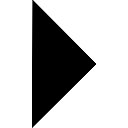
 显示该栏目以下所有产品
显示该栏目以下所有产品

